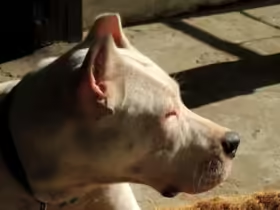Introduction
Dogs are known as man’s best friend, but how well do we truly understand them? While dogs may not communicate with words, they have an intricate system of body language that speaks volumes. As responsible pet owners, understanding dog body language is crucial in fostering a strong bond, ensuring their well-being, and preventing potential misunderstandings or behavioral issues. In this comprehensive guide, we will explore the various aspects of dog body language, from tail wagging to ear positioning, and uncover what your furry friend is really trying to say.
The Importance of Understanding Dog Body Language
Enhancing Communication and Strengthening Bonds
Just like humans, dogs communicate their feelings, intentions, and needs through non-verbal cues. By learning to read and respond to these signals, you can improve your communication with your dog, making interactions smoother and more positive. This understanding helps build trust and strengthens the bond between you and your pet.
Preventing Behavioral Issues
Misinterpreting or ignoring a dog’s body language can lead to confusion, frustration, and even behavioral problems. For instance, a dog that is feeling threatened or anxious might display subtle signs that, if unnoticed, could escalate into aggressive behavior. Understanding these signals allows you to address the root cause of your dog’s discomfort before it becomes a bigger issue.
Ensuring Safety
Recognizing when a dog is scared, anxious, or aggressive can prevent dangerous situations. This is especially important when interacting with unfamiliar dogs. Knowing how to approach or avoid a dog based on their body language can reduce the risk of bites or other negative interactions.
Key Elements of Dog Body Language
Tail Position and Movement
The tail is one of the most expressive parts of a dog’s body and can convey a wide range of emotions. However, it’s important to consider the tail’s position, movement, and the overall context to accurately interpret what your dog is trying to communicate.
- Neutral Tail: A relaxed tail in its natural position usually indicates a calm and content dog. This is their baseline state, where they feel comfortable and at ease in their environment.
- Wagging Tail: While many assume a wagging tail always means happiness, the speed and direction of the wag can tell a different story. A slow, broad wag often signifies friendliness or contentment, while a fast, stiff wag can indicate excitement or agitation. A wagging tail held high might suggest confidence or dominance, while a low, tucked wag can indicate fear or submission.
- Tail Tucked Between Legs: A tail tucked between the legs is a clear sign of fear, anxiety, or submission. In some cases, it may also indicate pain. This posture suggests that the dog is feeling threatened or uncomfortable and may need reassurance or space.
- Tail Held High and Rigid: A high, stiff tail often signifies alertness, confidence, or even aggression. The dog may be on guard or asserting dominance in a particular situation.
Ear Position and Movement
A dog’s ears are highly mobile and can provide significant insights into their mood and focus.
- Ears Up and Forward: When a dog’s ears are up and facing forward, it usually means they are alert, curious, or interested in something. This posture indicates that the dog is focused and ready to engage with their environment.
- Ears Back: Ears pinned back against the head can be a sign of fear, submission, or discomfort. In some cases, it may also indicate guilt, although this is often a misinterpretation by humans projecting their emotions onto the dog.
- Ears Relaxed: Ears in a neutral, relaxed position suggest that the dog is calm and at ease. This is a good indication that they are comfortable in their current environment.
- Ears Perked but Not Forward: If the ears are up but not facing forward, the dog may be assessing their surroundings or trying to determine the source of a sound or movement. This can indicate caution or uncertainty.
Eye Contact and Facial Expressions
A dog’s eyes can be very expressive, and understanding their eye contact and facial expressions is key to interpreting their emotions.
- Soft Eyes and Blinking: Soft, relaxed eyes with occasional blinking indicate a calm and happy dog. This expression shows that the dog is comfortable and trusts their surroundings.
- Direct Stare: A direct, unwavering stare can be a sign of dominance or aggression, especially if accompanied by a stiff body posture. However, in some cases, dogs may use a direct stare to try to communicate a need or desire, such as asking for food or attention.
- Whale Eye: When a dog shows the whites of their eyes (often referred to as “whale eye”), it typically indicates fear, anxiety, or discomfort. This is a sign that the dog is feeling threatened and may be on the verge of reacting defensively.
- Squinting: Squinting can be a sign of pain, submission, or even friendliness, depending on the context. In playful situations, it can be a sign that the dog is relaxed and not feeling threatened.
Mouth and Lips
The position and movement of a dog’s mouth and lips can reveal a lot about their emotional state.
- Relaxed Mouth: A relaxed mouth with slightly open lips often indicates a happy, content dog. If the dog’s mouth is open and they’re panting lightly, it’s usually a sign of relaxation.
- Licking Lips: Lip licking can be a sign of anxiety or stress, especially if there is no food involved. Dogs may also lick their lips as a calming signal to themselves or others.
- Bared Teeth: When a dog shows their teeth, it can indicate aggression, fear, or a defensive posture. However, it’s important to distinguish between an aggressive snarl and a playful grin, which some dogs display during friendly interactions.
- Yawning: Yawning can indicate that a dog is tired, but it’s also a common sign of stress or anxiety. Dogs may yawn to calm themselves in stressful situations.
Body Posture
A dog’s overall body posture can give you a clear indication of how they are feeling.
- Relaxed Body: A dog with a relaxed body posture, where the muscles are loose and the dog is standing or sitting comfortably, is typically calm and content.
- Tense Body: A tense, stiff body with weight shifted forward often indicates that the dog is on high alert or feeling threatened. This posture can precede aggressive behavior if the dog feels cornered or provoked.
- Cowering: A dog that is cowering with their body low to the ground and head down is displaying fear or submission. This posture may also include other signs such as a tucked tail and ears pinned back.
- Play Bow: The play bow, where a dog lowers their front legs and raises their hindquarters, is a clear invitation to play. This is a positive, friendly gesture that indicates the dog is feeling playful and non-threatening.
- Rolling Over: When a dog rolls onto their back and exposes their belly, it can be a sign of submission or trust. However, it can also be a way for the dog to ask for a belly rub, depending on the context and overall body language.
Vocalizations and Their Role in Body Language
While this guide primarily focuses on physical cues, it’s important to recognize that vocalizations also play a significant role in dog communication.
- Barking: Barking can have various meanings depending on the tone, pitch, and context. Excited, high-pitched barks often indicate happiness, while low, deep barks can suggest a warning or protective behavior.
- Growling: Growling is typically a warning sign, indicating that the dog is uncomfortable, threatened, or ready to defend themselves. However, growling can also occur during play, especially in roughhousing scenarios, so context is key.
- Whining: Whining often signals distress, anxiety, or a desire for attention. Dogs may whine when they are scared, in pain, or simply seeking comfort.
- Howling: Howling is a form of long-distance communication for dogs and can be triggered by various stimuli, such as sirens or other dogs howling. It can also be a sign of loneliness or separation anxiety.
Reading the Context: The Key to Accurate Interpretation
Understanding dog body language requires more than just observing individual signals; it’s about reading the entire context in which the behavior occurs. A wagging tail in one situation may mean something entirely different in another. To accurately interpret your dog’s body language, consider the following factors:
The Environment
Is your dog in a familiar or unfamiliar environment? Are there potential stressors present, such as loud noises, new people, or other animals? The environment plays a crucial role in shaping your dog’s behavior and body language.
The Dog’s Personality
Every dog is unique, with their personality influencing how they express themselves. Some dogs are naturally more confident and assertive, while others are shy and reserved. Knowing your dog’s personality will help you better understand their specific body language cues.
The Interaction
What is happening at the moment? Is your dog interacting with another dog, a person, or an object? Understanding the dynamics of the interaction can provide valuable context for interpreting your dog’s signals.
Past Experiences
A dog’s past experiences, whether positive or negative, can significantly impact their body language. For example, a dog that has been mistreated in the past may display more fearful or submissive behavior, even in situations where they are not directly threatened.
Practical Tips for Responding to Your Dog’s Body Language
Understanding dog body language is only the first step; knowing how to respond appropriately is equally important. Here are some practical tips for interacting with your dog based on their body language:
Approach Calmly and Respect Boundaries
If your dog is displaying signs of fear, anxiety, or discomfort, approach them calmly and avoid forcing interactions. Give them space to retreat if needed, and avoid direct eye contact, which can be perceived as threatening.
Use Positive Reinforcement
When your dog displays calm, relaxed body language, reward them with treats, praise, or affection. Positive reinforcement helps reinforce good behavior and encourages your dog to feel more comfortable in various situations.
Be Patient and Observant
Take the time to observe your dog’s body language in different situations and learn their unique cues. Patience is key, especially with dogs that may be more reserved or anxious.
Avoid Punishment
Punishing a dog for displaying fearful or aggressive body language can exacerbate the problem and damage your relationship. Instead, focus on positive reinforcement and creating a safe, supportive environment.
Seek Professional Help if Needed
If you’re struggling to understand or manage your dog’s body language and behavior, consider seeking help from a professional dog trainer or behaviorist. They can provide guidance and support tailored to your dog’s specific needs.
Conclusion
Understanding dog body language is an essential skill for any dog owner. By learning to read and interpret your dog’s non-verbal cues, you can enhance communication, strengthen your bond, and create a safer, more harmonious relationship. Remember, every dog is unique, so take the time to observe and learn your dog’s specific signals. With patience, empathy, and practice, you’ll become more attuned to what your dog is really saying, leading to a happier and more fulfilling life together.











Leave a Reply